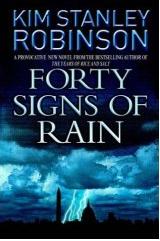tags: global warming, LabLit, science fiction, book review
 A friend of mine who is an editor at Random House Publishers sent me a fascinating book about global warming that I think qualifies as "LabLit." LabLit is short for "Laboratory Literature"; a new genre of fictional science literature that realistically portrays scientists working and living during contemporary times.
A friend of mine who is an editor at Random House Publishers sent me a fascinating book about global warming that I think qualifies as "LabLit." LabLit is short for "Laboratory Literature"; a new genre of fictional science literature that realistically portrays scientists working and living during contemporary times.
This book, Forty Signs of Rain by Kim Stanley Robinson (NYC, Bantam Books: 2004), is a peek into the lives of scientist, Anna Quibler, who works for the National Science Foundation (NSF), and her stay-at-home husband, Charlie, who telecommutes as the environmental advisor to Senator Phil Chase. The book also follows Anna's ascerbic and somewhat mysterious colleague, Frank Vanderwal, a fellow scientist on leave for one year from a biomedical research lab on the West Coast so he can also work at NSF.
This thoughtful and cerebral story begins when Anna notices a Buddhist delegation opening an embassy in the NSF building. She quickly befriends them and learns that they are from the small island country of Khembalung, near India. Khembalung is a member of the League of Drowning Nations; those countries that are vanishing beneath the rising oceans -- oceans that are rising due to the effects of global warming. As the story progresses, Anna and Charlie teach their new friends to work the challenging system of American politics and scientific grants and the Buddhists, in turn, affect the scientists in unexpected ways.
It becomes apparent throughout the book that, even though the scientists and the Khembalese were fully aware of the threat posed by global warming, they were helpless to make their warnings understood by politicians. Does this scenario sound familiar? As the scientists deal with the stresses and frustrations of their daily lives, the specter of global warming looms ominously everywhere, causing small changes here and there until abruptly, everything combines to bring about a frighteningly realistic disaster.
But the story is not all doom and gloom: moments of humor are provided as Charlie rides herd on his hyperactive toddler, Joe, who has a penchant for trouble.
I found Robinson's characters to be interesting and believable for the most part. But of all the characters in the book, I thought Frank was the most interesting because he is an idealist who has a clear vision of what NSF's role should be -- and his vision is in sharp contrast with reality. As a result, he is disillusioned with NSF throughout much of the book and longs for the opportunity to return to his job in California.
Even though this book is considered to be a work of science fiction, it shows a realistic side of science writing that should occupy a larger place in popular fiction. I was especially pleased that Robinson doesn't talk down to his readers, instead, he includes plenty of real-world science in the story so his predictions are not only plausible, but they echo eerily of events happening currently in the world. Additionally, the reader gains a deeper appreciation for the complex real-world challenges presented by global warming. Since this book is the first of a trilogy, it ends rather abruptly, as most trilogies do. However, that awkwardness aside, Forty Signs of Rain is a thought-provoking read and I am certainly looking forward to the next two books in this trilogy.
Kim Stanley Robinson has travelled and worked in different parts of the world (including Washington, DC and Switzerland) with his wife, Lisa, an environmental chemist. His work has won many awards including the Nebula Award ("The Blind Geometer" and Red Mars), the Asimov, John W. Campbell, Locus and World Fantasy Awards ("Black Air") and the Hugo Award (Green Mars).

If you haven't read the Mars trilogy, you must. They are much more speculative, but they maintain a sense of realism, and KSR's characters are almost second to none.
Great book from one of my favorite authors. I'm almost through the second book and have the third in the queue: good stuff, all the way. I second Tim's recommendation for the Mars trilogy, and in a different vein, found "The Years of Rice and Salt" profound and moving: not so much sci-fi as much as alternate history, with more emotional context.
The Mars trilogy kinda depressed me, actually. All that stuff about changing the climate, destroying the gorgeous dust storms and polluting the land with alien life left me strongly agreeing with the terrorist groups blowing it up.
Go look at "The Gold Coast", its my favorite KSR book. Its a neat look at how the future appeared in the 80s. Part of some kind of trilogy called Three Californias.
KSR has never been my favourite author, though the Three Californias is a reasonable read and interesting even if only because it reveals how the 80s envisioned the future possibilities.
It is his characters that I didn't care for, though as you say the characters in this book are believable I'll give it a read when I can.
I liked Twenty Signs of Rain, but the sequel was somehow unconvincing (sorry, I developed an allergy to the tree house story, which I find highly unnecessary, and I didn't like the introduction of the "spiritual" side much either).
I will probably read the third, but without much enthousiasm, and hoping it will ressemble the first book more than the second one.
Chris: in this book, i found Anna Quibler to be the least believable character.
Mag: i have already finished the sequel (read my review here) and am awaiting a copy of the last installment in the trilogy.
I will be checking my library for this book.